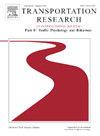Do dotted extensions help guide drivers at a transition area of partial-shadowed left-turn lane? An investigation based on eye movement behavior and visual attention
IF 3.5
2区 工程技术
Q1 PSYCHOLOGY, APPLIED
Transportation Research Part F-Traffic Psychology and Behaviour
Pub Date : 2024-10-19
DOI:10.1016/j.trf.2024.10.009
引用次数: 0
Abstract
When adding an exclusive left-turn lane at an intersection, a transition area is needed to allow through and left-turn traffic to move into appropriate lanes smoothly. However, whether a dotted extension should be applied at such a transition area remains inconclusive. The need for recommending a dotted extension is further complicated at intersections where an approach taper partially shadows a left-turn lane. This study aims to shed light on whether dotted extensions should be recommended in a transition area and research the impacts of dotted extensions on guiding drivers from their perspectives. Scenarios with and without dotted extensions were created for a video-viewing experiment. Driver eye movement behavior and cognitive load rating served as evaluation indicators in each target scenario. Thirty participants were recruited and randomly assigned to with and without dotted extension groups. Results show that: (1) With the dotted extension, participants could focus on fewer objects and, therefore, would not need to divert their visual attention toward the surrounding vehicles. (2) The dotted extension assists through-traffic drivers in maintaining more focused attention on information critical to their driving task. (3) Dotted extensions help drivers reduce stress, mainly because of clearer indications of lane configuration. Altogether, our findings suggest that a road with dotted extensions provides better guidance in a transition area than one without dotted extensions.
在部分阴影左转车道的过渡区域,点状延伸线是否有助于引导驾驶员?基于眼动行为和视觉注意力的研究
在交叉路口增设专用左转车道时,需要一个过渡区,以便让通行车辆和左转车辆顺利驶入相应的车道。不过,在这种过渡区是否应采用虚线延长,目前仍无定论。在进路锥形线部分遮挡了左转车道的交叉路口,建议采用点状延伸的必要性变得更加复杂。本研究旨在阐明是否应在过渡区域推荐点状延长线,并从驾驶员的角度研究点状延长线对引导驾驶员的影响。在视频观看实验中,创建了有虚线延伸和无虚线延伸的场景。在每个目标场景中,驾驶员的眼动行为和认知负荷评级都是评价指标。实验招募了 30 名参与者,并将他们随机分配到带点延伸组和不带点延伸组。结果显示(1) 有了点状延伸线,参与者可以将注意力集中在更少的物体上,因此不需要将视觉注意力转移到周围的车辆上。(2) 点状延伸线有助于穿行交通的驾驶员将更多的注意力集中在对其驾驶任务至关重要的信息上。(3)点状延伸有助于驾驶员减轻压力,这主要是因为车道配置的指示更加清晰。总之,我们的研究结果表明,在过渡区域,有虚线延长线的道路比没有虚线延长线的道路能提供更好的引导。
本文章由计算机程序翻译,如有差异,请以英文原文为准。
求助全文
约1分钟内获得全文
求助全文
来源期刊
CiteScore
7.60
自引率
14.60%
发文量
239
审稿时长
71 days
期刊介绍:
Transportation Research Part F: Traffic Psychology and Behaviour focuses on the behavioural and psychological aspects of traffic and transport. The aim of the journal is to enhance theory development, improve the quality of empirical studies and to stimulate the application of research findings in practice. TRF provides a focus and a means of communication for the considerable amount of research activities that are now being carried out in this field. The journal provides a forum for transportation researchers, psychologists, ergonomists, engineers and policy-makers with an interest in traffic and transport psychology.

 求助内容:
求助内容: 应助结果提醒方式:
应助结果提醒方式:


